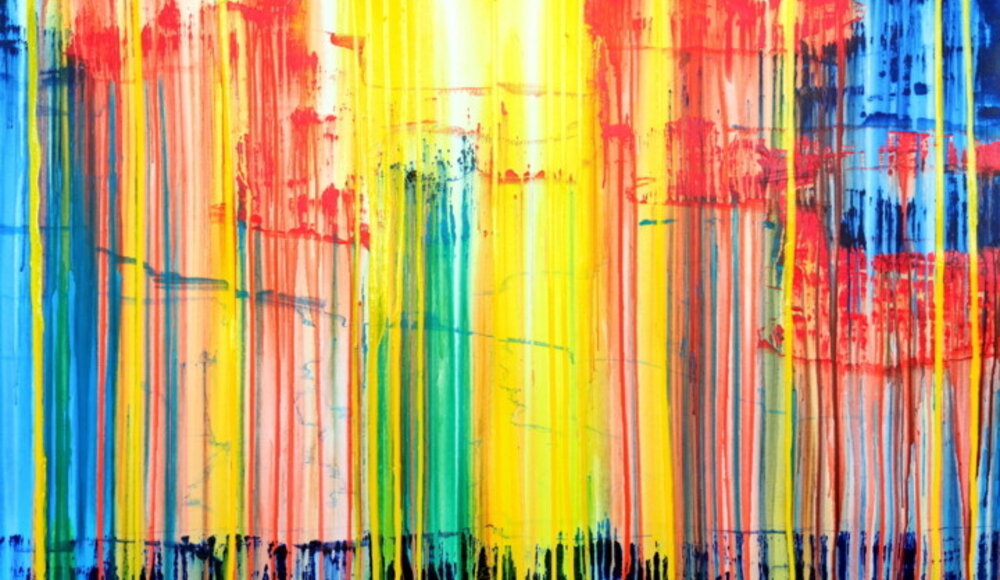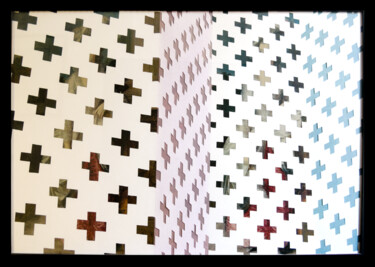 Carla Sá Fernandes, The emotional creation #356, 2022. Acrylic on canvas, 90 x 120 cm.
Carla Sá Fernandes, The emotional creation #356, 2022. Acrylic on canvas, 90 x 120 cm.
Brief history of Portuguese art
The history of Portuguese art represents a narrative that refers to multiple cultures and influences; in fact, primarily responsible for the birth, and establishment, of sculpture and painting in this country were the French and Dutch artistic traditions, as well as those of Spain and Italy. With regard to sculpture, it became established in Portugal in the first part of the 16th century, that is, when the work of the leading French Renaissance artists, skilled workers in marble and alabaster, became widespread. As for painting, on the other hand, its emergence is due to the Netherlands and, in particular, to the great master Jan van Eyck, who, during the 15th century, visited Lisbon on the occasion of the marriage of King João I's daughter, an event to which we owe the beginning of a long and close relationship between the figurative cultures of the two countries. It was precisely from Flemish art that Portuguese art borrowed, both the technical and compositional skills and the emerging pictorial traditions related to the depiction of painted subjects and the portrait genre, as evidenced by the famous Polyptych of St. Vincent (1458-1464) by Nuno Gonçalves, now on display at the Museum of Ancient Art in Lisbon. Despite these strong Dutch influences, between the end of the 15th century and the beginning of the following century, a distinctly Portuguese style also emerged, which, called Manueline, marked the transition from Gothic to Renaissance in Portugal. This trend, of which the greatest exponent turns out to be Grão Vasco, derived from the sea, as it combined Christian iconography with the depiction of shells, coral branches, heraldic coats of arms, and fanciful aquatic forms, which, in a sense, anticipated the surrealism of Salvador Dali. In addition, the Lisbon School, a group owned by a variety of talented painters, including Jorge Afonso, Cristovão de Figueiredo, Garcia Fernandes and Gregório Lopes, also established itself during the same period. However, these Portuguese art forms suffered a sharp decline during the sixty years of the Kingdom of Spain, that is, starting in 1580, when the new Spanish rulers restored classical motifs from Italy. Speaking of the 18th, 19th, and 20th centuries, they were instead marked by portraiture, the Romantic, Naturalist, and Realist movements, but also by the influences of Cubism, Dadaism, Abstractionism, and Expressionism, just as the work of the famous Portuguese painter Amadeo de Souza Cardoso, who was particularly influenced by the latter four trends, demonstrates. Finally, while at first glance Portugal's artistic tradition may be less popular and original than others, it is certainly perceived as more intriguing because it is less investigated, publicized, exploited, and, consequently, known. Moreover, it is possible to marvel at the success found by many contemporary Portuguese artists, including, for example: Paula Rego, a painter whose surrealist narratives have enabled her to establish herself in the international art world; Joana Vasconcelos, an artist who boasts three participations in the Venice Biennale; and Santiago Ribeiro, one of Portugal's most active surrealist.
 Martinho Dias, Throne, 2019. Acrylic on canvas, 130 x 110 cm.
Martinho Dias, Throne, 2019. Acrylic on canvas, 130 x 110 cm.
 Cristiano Felismina, Iris, 2021. Oil on canvas, 124 x 94 cm.
Cristiano Felismina, Iris, 2021. Oil on canvas, 124 x 94 cm.
 José Malhoa, O Fado ,1910. Oil on canvas, 150 x 183. Lisbone: Museu de Lisboa.
José Malhoa, O Fado ,1910. Oil on canvas, 150 x 183. Lisbone: Museu de Lisboa.
O Fado: a Portuguese masterpiece unveiled
O Fado is a painting by José Malhoa (1855 -1933) of which two versions are known: one from 1909 and the other from 1910. The aforementioned master represented Portuguese art within the pictorial current of naturalism, a movement that, developed in France around 1870, pursued the goal of realistically depicting urban and suburban landscapes in which people, animals and objects, found their place. Returning to the masterpiece in question, it immortalizes a well-known tradition of Portuguese culture, namely fado, a musical genre, which, born in Lisbon and Coimbra in the 1820s, is marked by a type of melancholic melody, in which most of the songs speak of nostalgia, grief and loss, found in themes related to the sea and the life of the most popular neighborhoods. The work was conceived when José Malhoa felt the desire to portray such a musical tradition, as it was precisely during his era that it began to enjoy some success even among the bourgeoisie, intellectuals and aristocrats. In order to pursue the aforementioned intent, the artist at first hired two professional models, but soon after, being dissatisfied with the result, he decided to capture the true essence of fado by immortalizing more authentic characters. Thus, right in the Mouraria (Lisbon) district, the cradle of this musical genre, the painter found the protagonists of his painting: Amâncio Augusto Esteves, fado singer and guitarist, and Adelaide da Facada by day a lottery ticket seller and by night a prostitute. The latters' various outbursts of jealousy and multiple problems with the police often tested Malhoa's patience, who, despite a variety of caricature situations, managed to bring one of his most famous figurative projects to a conclusion. Finally, this work powerfully represents how, to the example of French naturalism, he joined a personal, and more national, point of view aimed at making this movement "exclusively" Portuguese.
 Rita Melo, Error.IV, 2021. Oil on canvas, 50 x50 cm.
Rita Melo, Error.IV, 2021. Oil on canvas, 50 x50 cm.
 Rúben López, The blessed, 2021. Watercolor on paper, 22 x 30 cm.
Rúben López, The blessed, 2021. Watercolor on paper, 22 x 30 cm.
The Portuguese artists of Artmajeur
Returning to the contemporary, the works of the Portuguese artists of Artmajeur are able to express the full potential of an artistic production, which has always been capable of making the most celebrated figurative tradition its own, through refined and highly personal experimentation. In fact, an example of what has just been stated are the ever new interpretations of currents, movements, genres and major Western artistic trends, found in Paulo Vilarinho's digital art, Angelo Ribeiro's sculpture and Cfey's painting.
 Paulo Vilarinho, Lady Maria, 2018. Photomontage / digital painting on paper, 27 x 22 cm.
Paulo Vilarinho, Lady Maria, 2018. Photomontage / digital painting on paper, 27 x 22 cm.
Paulo Vilarinho: Lady Maria
Paulo Vilarinho is a Portuguese visual artist born in 1972, whose digital art, the result of a mix between collage and photographic manipulation, pursues the purpose of showing various elements at the same time, generating a particular mixture of order, beauty and chaos, which turns out to be largely inspired by Surrealism, Conceptual Art and Expressionism. As for Lady Maria, the work is part of the Recycled series, in which, since the beginning of 2017, the artist has wanted to repurpose old masterpieces from the Renaissance and Neoclassicism, revisiting and personalizing them. The purpose of such an approach is to invite the viewer to travel within the world of memories, pursuing the intention of rediscovering a "lost" masterpiece from the past, which now lives again, with new guises, in our present. In the specific case of Lady Maria, the digital painting turns out to be a "remake" of Lady Maria Conyngham, a romantic portrait by Sir Thomas Lawrence, which, dated c. 1824, is preserved at the Metropolitan Museum of Art in New York.
 Angelo Ribeiro, Lazarim Devil, 2019. Metal sculpture, Height 70cm, Width 40cm, Depth 20cm / 15.00 kg.
Angelo Ribeiro, Lazarim Devil, 2019. Metal sculpture, Height 70cm, Width 40cm, Depth 20cm / 15.00 kg.
Angelo Ribeiro: Lazarim Devil
The metal sculpture by Angelo Ribeiro, a Portuguese artist born in 1967, seems to allude, at first glance, to the great curiosity of the Portuguese people, who have not only limited themselves to reinterpreting Western art, but also African art, famous for its ritual masks. In fact, the aforementioned falls perfectly within the principles of primitivism, an artistic trend, which, developed in the 19th century, contaminated European art with its archaic connotations, that is, those influences from peoples not yet "shaped" by Western cultures. In addition, the purpose of this type of artistic investigation, characterized by a clear simplification of images, was also to be able to give vent to the motions of the soul with extreme simplicity and purity. Although Angelo Ribeiro's sculpture may seem to be a modern interpretation of African primitivism, it actually refers to the purest Portuguese tradition, as it draws inspiration from the masks of the carnival of Lazarim and, in particular, from the "Caretos," devilish and mysterious male figures that animate the festivity.
 Cfey, The King, 2021. Acrylic / collage on canvas, 100 x 100 cm.
Cfey, The King, 2021. Acrylic / collage on canvas, 100 x 100 cm.
Cfey: The king
Cfey's painting, echoing the artist's own words, refers to a "cult" event from 1999, namely "Kasparov versus the World": the iconic chess match in which Russian Garri Kasparov, the reigning world chess champion, and the team representing the Rest of the World (World Team) faced each other via the Internet. That competition, held on MSN Gaming Zone servers and sponsored by First USA bank, was won by Kasparov after 62 moves, a fact most likely alluded to in the title of the work itself. Looking at the somatic features of the canvas' protagonist, however, we realize that he has the features of another "king," namely Michelangelo's David, the undisputed symbol of male beauty of all time. The marble statue, dated 1501-04 and kept at the Galleria dell'Accademia in Florence, represents for all intents and purposes another victor: The young David, who, with a proud posture, is focused on the fulfillment of the act of war against the giant Goliath.


 Olimpia Gaia Martinelli
Olimpia Gaia Martinelli























